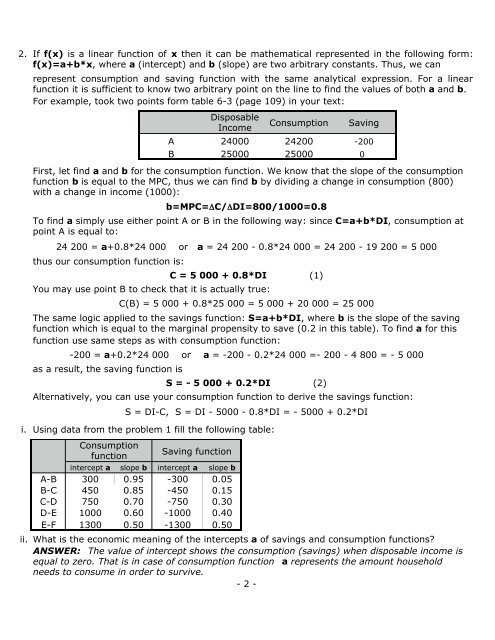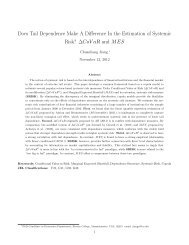Answer Key - Problem Set 3
Answer Key - Problem Set 3
Answer Key - Problem Set 3
Create successful ePaper yourself
Turn your PDF publications into a flip-book with our unique Google optimized e-Paper software.
2.<br />
If f(x) is a linear function of x then it can be mathematical represented in the following form:<br />
f(x)=a+b*x, where a (intercept) and b (slope) are two arbitrary constants. Thus, we can<br />
represent consumption and saving function with the same analytical expression. For a linear<br />
function it is sufficient to know two arbitrary point on the line to find the values of both a and b.<br />
For example, took two points form table 6-3 (page 109) in your text:<br />
Disposable<br />
Income<br />
24000<br />
25000<br />
Consumption<br />
Saving<br />
First, let find a and b for the consumption function. We know that the slope of the consumption<br />
function b is equal to the MPC, thus we can find b by dividing a change in consumption (800)<br />
with a change in income (1000):<br />
thus our consumption function is:<br />
C = 5 000 + 0.8*DI (1)<br />
You may use point B to check that it is actually true:<br />
A<br />
B<br />
24200<br />
25000<br />
b=MPC=ΔC/ΔDI=800/1000=0.8<br />
To find a simply use either point A or B in the following way: since C=a+b*DI, consumption at<br />
point A is equal to:<br />
C(B) = 5 000 + 0.8*25 000 = 5 000 + 20 000 = 25 000<br />
The same logic applied to the savings function: S=a+b*DI, where b is the slope of the saving<br />
function which is equal to the marginal propensity to save (0.2 in this table). To find a for this<br />
function use same steps as with consumption function:<br />
-200<br />
24 200 = a+0.8*24 000 or a = 24 200 - 0.8*24 000 = 24 200 - 19 200 = 5 000<br />
-200 = a+0.2*24 000 or a = -200 - 0.2*24 000 =- 200 - 4 800 = - 5 000<br />
as a result, the saving function is<br />
S = - 5 000 + 0.2*DI (2)<br />
Alternatively, you can use your consumption function to derive the savings function:<br />
S = DI-C, S = DI - 5000 - 0.8*DI = - 5000 + 0.2*DI<br />
0<br />
i.<br />
ii.<br />
Using data from the problem 1 fill the following table:<br />
Consumption<br />
function<br />
Saving function<br />
intercept a slope b intercept a slope b<br />
A-B<br />
B-C<br />
300<br />
450<br />
0.95<br />
0.85<br />
-300<br />
-450<br />
0.05<br />
0.15<br />
C-D<br />
D-E<br />
E-F<br />
750<br />
1000<br />
1300<br />
0.70<br />
0.60<br />
0.50<br />
-750<br />
-1000<br />
-1300<br />
0.30<br />
0.40<br />
0.50<br />
What is the economic meaning of the intercepts a of savings and consumption functions?<br />
ANSWER: The value of intercept shows the consumption (savings) when disposable income is<br />
equal to zero. That is in case of consumption function a represents the amount household<br />
needs to consume in order to survive.<br />
- 2 -

















